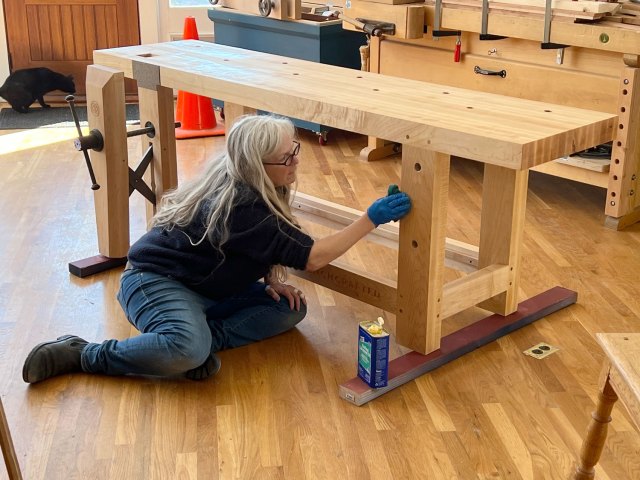
We have just received delivery of a new Benchcrafted Classic Bench in our shop, which replaces Megan Fitzpatrick’s LVL bench in the center of our bench room. Megan and I have been in long-running discussions about building her a new workbench sometime during 2022. But recently we decided to buy (actually, trade) for the Benchcrafted bench. Here’s why.
I’ve built a lot of workbenches since 2000, written five books about workbenches and have been hailed/derided for popularizing the 18th-century French bench for woodworkers who like to use hand tools. And when Megan first approached me about replacing her bench, I said I was happy to help build her a new one based on plans in “The Anarchist’s Workbench” (the book is free to download).
But after looking ahead at our schedule for 2022, my brain began to do the math. I can build a bench in about 40 hours of work. The hardware would be about $400. The wood would be about $500. On the other hand, the Benchcrafted Classic is $2,900. After about 5 seconds of ciphering (and carrying the gazinta), the decision to order the Benchcrafted was obvious.

First, the bench completely fulfills my dictum for a good workbench: That you can work on the faces, edges and ends of boards with ease. The Benchcrafted Classic comes with a Crucible holdfast and a planing stop (they added our planing stop by request), and the holdfast pattern is the same pattern that’s on my workbench.
The bench’s form is based on the 18th-century plan. The joints are drawbored. The raw material is hard maple. And the bench weighs plenty for handwork – 300 lbs. The craftsmanship is excellent – as good as any workbench I’ve made. The joints are tight. The vise runs smooth. And the top is flat.
The bench even comes unfinished – a real blessing. Today Megan added a boiled linseed oil finish to the bench, which suits the way we work. A straight oil finish adds a little protection and color, without adding any slipperiness that comes from a wax or varnish.
If you have been reading my books on workbenches, then you know that this Benchcrafted bench pushes all of my buttons. Benchcrafted got it exactly right with no compromises. And they made it for less than I could, at my hourly rate.
So about the payment. I was perfectly happy to pay cash for this bench. But Jameel and FJ said they were interested in trading the bench for one of my stick chairs and a Dutch tool chest made by Megan. So everyone is happy.
Megan has a new workbench with a leg vise that works perfectly. Her LVL workbench is going to live in her basement as “an expansive horizontal storage facility.”* And I’m sure it will be used as a workbench. It’s still a good bench – it has just been eaten up and beaten up by all the workholding experiments I’ve inflicted upon it.
And I have 40 more hours this year that I can use to work on other projects – chairs, refurbishing the bar in our storefront, books and new tools for Crucible.
Now I just need to figure out what to do with our Ulmia workbench, my least favorite bench in the shop. And then the workshop will be complete (cue the laugh track).
— Christopher Schwarz

*Megan here. I do still love my LVL bench, and the top remains dead flat after 11-plus years of hard use – an excellent result from our material experiment. But we also built the base out of LVL, and that was less successful. The stuff is made to compress a bit (to handle earthquakes and the like), and compress it did from the force of the leg vise against the top; the top got pushed back from the front of the leg over time – and despite many efforts to fix it, nothing worked for long.
Now, I have a scabbed-on piece of plywood at the top of the leg to bring that front edge flush…but I know it will move again.
It’s not that big a deal to me; I’m used to it and have myriad workarounds – but I don’t like it when students have a less-than-perfect experience with our equipment, hence my desire to build a new bench. But I am delighted to not build one. I have plenty to be going on with, too, and the Benchcrafted Classic is darn close to what I would have built anyway – basically a larger, heavier version of the petite white pine Roubo in my basement shop (which features an OG Benchcrafted Glide vise).
So now I’ll have two good benches in my basement shop – one little, one big. Oh – and one crappy built-in “bench” – I use the term loosely – that was left by a previous owner. It is indeed a horizontal storage facility. The two actual benches, however, will get used for woodworking. In my free time.
— Fitz










